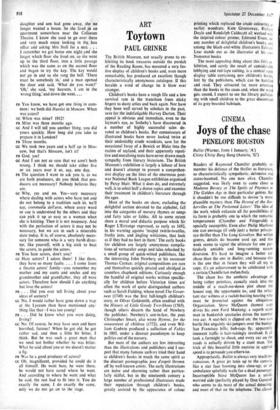Toytown
ART PAUL GRINKE
The British Museum, not usually prone to ex- hibiting its book treasures outside the purdah of the Reading Room, has mounted a very fes- tive display of children's books and, even more remarkable, has produced an excellent though characteristically anonymous catalogue. If this heralds a wind of change let it blow ever stronger.
Children's books have a rough life and a low survival rate in the transition from sticky fingers to dusty attics and back again. Nor have they been well served by scholars in the past, save for the indefatigable Harvey Dorton. Their appeal is obvious and immediate, even to the layman's eye, as Sotheby's have discovered in a number of highly successful sales de- voted to children's books. But connoisseurs of illustrated books have never looked twice at their undeniably crude woodcuts, save for the occasional foray of a Bewick or Blake into the realms of toyland, and their apparently repeti- tive and moralising texts have never drawn much sympathy from literary historians. The British Museum's exhibition is largely a labour of love and doesn't attempt to present a comprehen- sive display on the lines of the enormous post- war National Book League exhibition organised- by Percy Muir. What it does do, and extremely well, is to select half a dozen topics and examine their treatment in children's literature through the ages.
Most of the books on show, excluding the delightful section devoted to the alphabet, fall into the categories of nursery rhymes or songs
and fairy tales or fables. All to some extent share a moral and didactic purpose which Sir.
Roger L'Estrange expressed, as early as 1692, in his warning against 'insipid twittle-twattles, frothy jests, and jingling witticisms, that look as if they had no hurt in them.' The early books for children are largely anonymous compila- tions of vernacular songs and tales rehashed by a small group of quick-witted publishers, like the interesting John Newbery or his successor Thomas Canaan; original compositions are rare and themselves quickly pirated and abridged in countless chapbook editions. Curiously enough the handful of original works written specific- ally for children before Victorian times are often the work of quite distinguished authors such as Sarah Fielding, whose novel The Gover- ness (1749) was the first full-length children's story, or Oliver Goldsmith, often credited with the History of Little Goody Two-Shoes (1765), though others discern the hand of Newbery the publisher. Newbery's son-in-law, the poet Christopher Smart, also wrote Hymns, for the amusement of children (1772), and even Wil- liam Godwin produced a collection of Fables in 1805, under a discreet pseudonym to keep politics out of the nursery.
But most of the authors are less interesting than the illustrations and publishers and I sus- pect that many famous authors tried their hand at children's books in much the same spirit as the discreet pornographic jeux d'esprit thrown off by well-known artists. The early illustrations are naive and charming rather than particu- larly skilful, but in the nineteenth century a large number of professional illustrators made their reputation through children's books, greatly assisted by the appearance of colour
printing which replaced the crude colouring 0; earlier woodcuts. Kate Greenaway, Richarc Doyle and Randolph Caldecott all worked with the inspired colour printer, Edmund Evans, on any number of delightful children's books, and among the black-and-white illustrators Edward Lear stands out as the illustrator of his owl. Nonsense books.
The most appealing thing about this little ex hibition, and surely the result of considerable lobbying and red-tape cutting, is a central open display table containing new children's books, lent by the publishers, which can be handled and read. They attracted far more attention than the books in the cases and, when the word gets round, I expect to see the library pullulat- ing with small children to the great discomfort of its grey-bearded habitues.


































 Previous page
Previous page